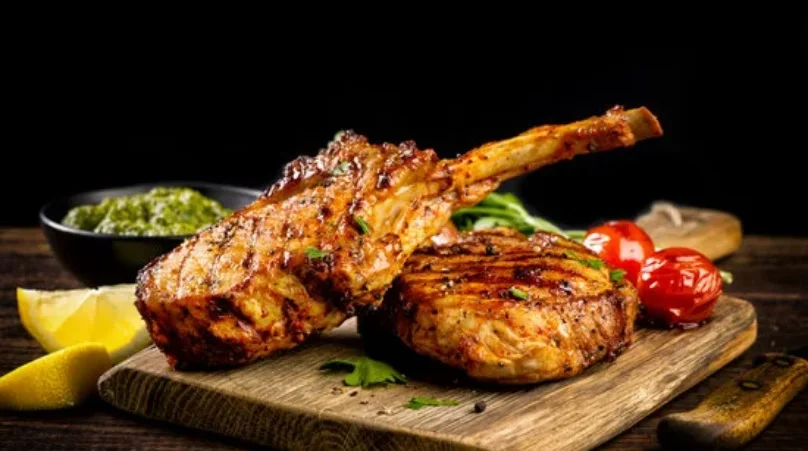The tomahawk steak is a culinary marvel that has captivated the hearts of meat connoisseurs around the world. Its distinctive appearance, characterized by a thick, bone-in ribeye cut with an extended bone resembling a tomahawk axe, makes it not only a feast for the taste buds but also a visual spectacle. This article delves into the rich history, unique characteristics, and precise cooking methods that elevate the tomahawk steak to a gastronomic delight.
The Origins and Characteristics of Tomahawk Steak
Origins
The tomahawk steak is derived from the fore-rib of the cow. This particular cut traces its origins to the rib primal, which spans ribs six through twelve. The tomahawk steak specifically comes from the sixth through the twelfth rib, offering a premium cut renowned for its marbling and tenderness. The bone, left intact and extending well beyond the meat, gives the steak its iconic tomahawk shape.
Characteristics
- Marbling: One of the defining features of the tomahawk steak is its extensive marbling. Marbling refers to the intramuscular fat interspersed within the muscle. This fat melts during cooking, infusing the meat with a rich, buttery flavor and ensuring a tender texture.
- Thickness: A typical tomahawk steak is exceptionally thick, often ranging from 2 to 2.5 inches. This substantial thickness requires careful cooking to ensure even heat distribution and optimal doneness.
- Bone-In: The extended bone serves both aesthetic and functional purposes. It provides a handle for easy maneuvering during cooking and adds flavor to the meat as the bone marrow melts and permeates the steak.
The Art of Cooking a Tomahawk Steak
Cooking a tomahawk steak requires a combination of techniques to achieve the perfect sear and internal temperature. The following step-by-step guide outlines a method that guarantees a mouth-watering, tender, and juicy steak.
Step 1: Preheat the Oven and Pan
Begin by preheating your oven to 200°C (392°F). Place a cast-iron skillet or oven-safe pan in the oven to heat up. Preheating the pan ensures an even sear when the steak is placed on it.
Step 2: Season the Steak
Generously season the tomahawk steak with salt and pepper or your preferred steak seasoning. Ensure that the seasoning covers all sides of the steak to enhance the flavor profile.
Step 3: Sear the Steak
Remove the preheated pan from the oven and place it on the stove over high heat. Add a tablespoon of oil to the pan, swirling it around to coat the surface evenly. Carefully place the steak in the pan and let it sear for 3-4 minutes. This initial searing creates a flavorful crust by caramelizing the meat’s natural sugars.
Step 4: Flip and Sear the Other Side
After searing one side, flip the steak over and sear the other side for another 3-4 minutes. The goal is to develop an even crust on both sides while retaining the steak’s juicy interior.
Step 5: Sear the Edges
Using tongs, hold the steak and sear the edges, including the bone. This step ensures that the entire surface of the steak is evenly browned and flavorful.
Step 6: Finish in the Oven
Transfer the seared steak to the oven to finish cooking. Depending on the thickness of the steak and your desired level of doneness, this can take anywhere from 10 to 20 minutes. Use a meat thermometer to check the internal temperature. For a medium-rare steak, aim for an internal temperature of 55°C (130°F).
Step 7: Rest the Steak
Once the steak reaches your desired doneness, remove it from the oven and let it rest for at least 10 minutes. Resting allows the juices to redistribute throughout the meat, resulting in a moist and flavorful steak.
Step 8: Slice and Serve
Slice the steak against the grain to ensure tenderness. Serve it with your favorite sides and sauces, and enjoy the rich, succulent flavors of the tomahawk steak.

Enhancing the Tomahawk Experience
Pairing with Sides
A tomahawk steak pairs wonderfully with a variety of side dishes. Consider serving it with classic options such as mashed potatoes, grilled vegetables, or a fresh salad. For a more decadent meal, truffle fries or a creamy mushroom sauce can elevate the dining experience.
Wine Pairings
A robust red wine complements the rich flavors of a tomahawk steak. Consider pairing it with a Cabernet Sauvignon, Malbec, or Syrah. These wines have the body and tannins to match the steak’s bold flavor and marbling.
Grilling Alternative
While the oven method is popular, grilling the tomahawk steak is another excellent option. Preheat your grill to high heat and follow the same searing and resting steps. Grilling adds a smoky flavor that pairs beautifully with the steak’s natural richness.
The Tomahawk Steak in Culinary Culture
The tomahawk steak has transcended its origins to become a symbol of luxury and culinary excellence. Its impressive size and presentation make it a centerpiece at upscale restaurants and special occasions. Chefs and home cooks alike appreciate the tomahawk steak for its flavor, tenderness, and dramatic appearance.
Restaurant Menus
Many high-end steakhouses feature the tomahawk steak as a signature dish. Its presentation, often served on a wooden board with the bone prominently displayed, adds to the dining experience. Restaurants may offer the steak with various accompaniments, such as compound butter, roasted garlic, or specialty sauces.
Home Cooking
For home cooks, preparing a tomahawk steak is an opportunity to showcase culinary skills and create memorable meals. The process of cooking this steak, from seasoning to searing to serving, is a rewarding experience that results in a delicious and visually stunning dish.
Conclusion
The tomahawk steak is more than just a cut of beef; it is a culinary masterpiece that combines flavor, tenderness, and visual appeal. By following the outlined cooking methods, anyone can achieve a perfectly cooked tomahawk steak that will impress and delight diners. Whether enjoyed at a fine dining establishment or prepared at home, the tomahawk steak remains a timeless favorite among meat lovers.









